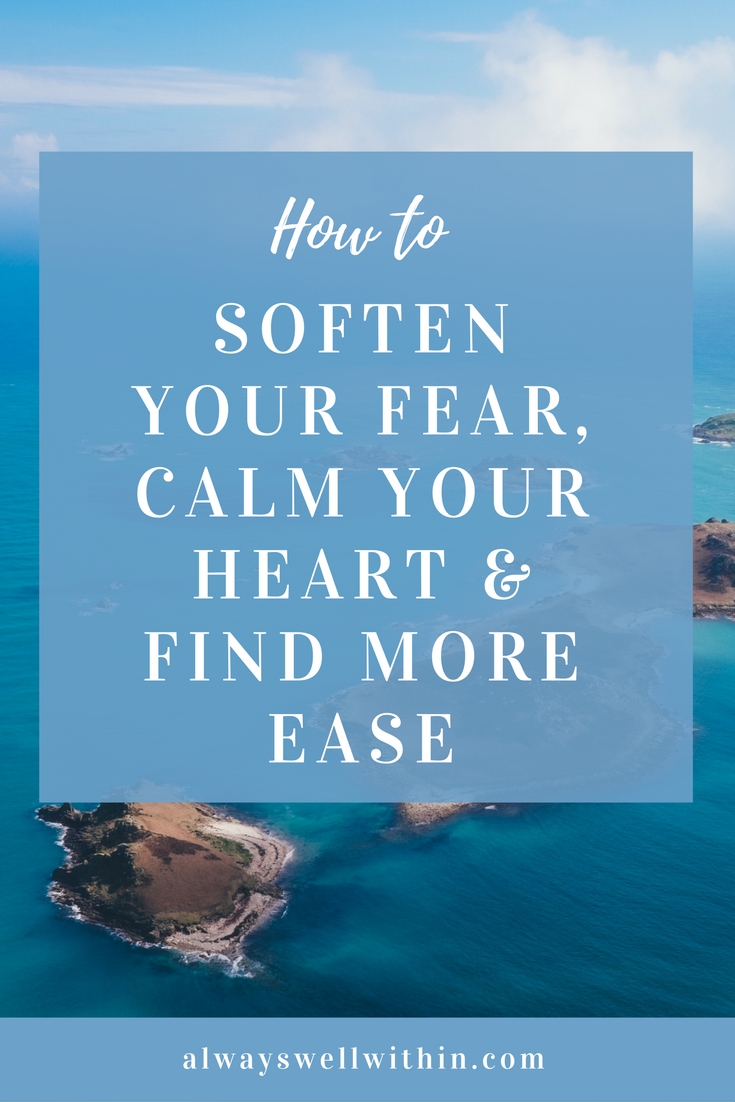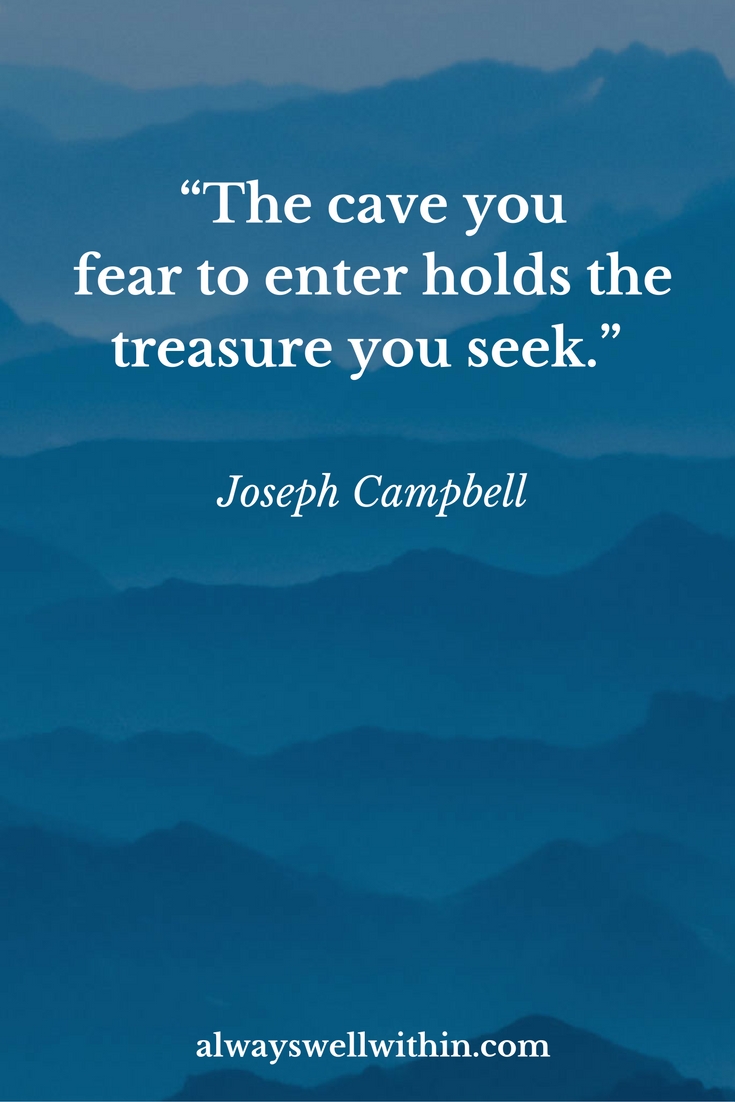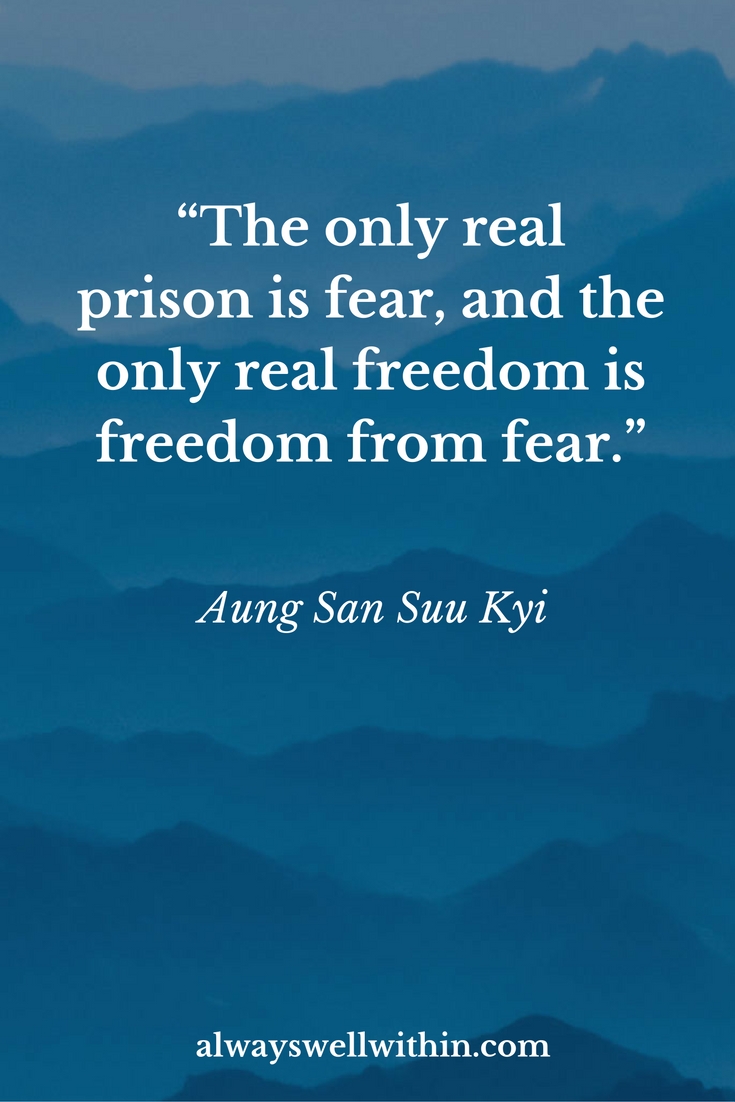 Recently, I’ve found myself asking, “What is the opposite of fear?”
Recently, I’ve found myself asking, “What is the opposite of fear?”
Some people might say courage, but I think this could be a mistake when it comes to deeply embedded fear. You can easily reinforce fearfulness or trauma by pushing yourself to be “courageous,” or trying to go too fast.
If you would like to listen to me read this post, click below or download the audio.
[audio mp3="http://alwayswellwithin.com/wp-content/uploads/2016/12/Soften-Fear.mp3"][/audio]
I find relaxation through body awareness a better starting point to counteract the kind of fear that’s been frozen in time, implanted in the body, and hidden in deeper recesses of the mind. Fear is about contraction, isn’t it? Whereas relaxation through body awareness allows for expansion.
How Body Awareness Is Helping Me to Heal Fear and Trauma
I’ve lived in fear my entire life except for a few short years when I displayed the naive and cocky fearlessness of a teenager and young adult.
At that stage, I might have been able to let go of the fear generated in my childhood. But traumatic events during my young adult years sealed the deal between me and fear. For decades, it never occurred to me that I could overcome the constant unease or heal trauma as it felt so deeply fixed in my being, beyond my conscious control. And, very little was known about how to heal trauma back then.
I soldiered on, accomplishing all that I could, pretending to be clear and confident. Despite the appearance of bravado, all those years fear buzzed along my nerves, constricted my muscles, played havoc in my gut, and finally sent my immune system into overdrive. As trauma survivors often do, hoping for a new chance at resolution, I unconsciously chose people, situations, and circumstances that repeated the trauma in other ways, deepening its impact on my body and brain.
At the same time, I was heavily invested in believing I was “fine.” I didn’t consciously understand all the ways that fear and trauma ran my life and ran me down emotionally, mentally, and physically until I came to Hawaii six years ago. By that time, I was wound up in knots, triggered by the least little thing.
In the summer of 2015, I started working with a therapist who practices both Somatic Experiencing (SE),a body-oriented approach to healing trauma and other stress disorders and the Neuroaffective Relational Model (NARM) which blends somatic (body-based) mindfulness with a relational approach to address developmental (childhood) trauma. Both approaches emphasize self-regulation of the nervous system and a gradual, safe increase in body awareness These methods have proven to be ideal for me.
Because of the complexity of my personal traumas and long-held fear, healing doesn’t come easily. But sure and steady is doing the trick. I see marked changes in my ability to set boundaries, greater confidence, and a lessening of traumatic reactions and sensitivity.

Now that I’ve established a sense of safety and confidence through trauma therapy, I feel ready to bring more body awareness and relaxation into my life on a daily basis. Today, I'd like to share 3 simple practices I use for this purpose, but first let's look at how body awareness can help you - because body awareness isn't just for trauma survivors.
What You Can Gain Through the Practice of Body Awareness
Modern norms encourage us to live in our heads, but so much can be gained from inhabiting the body. Body awareness can help you to:
- See the connection between emotions and physical sensations.
- Allow sensations and emotions to arise and subside without entering into distress.
- Heal deep emotional wounds.
- Understand your true feelings and desires.
- Feel centered in yourself and more confident.
- Find relief from stress and pain.
- Listen to the messages of your body so you can circumvent illness.
- Achieve more clarity so you can make good decisions and overcome obstacles.
- Open to more joy and happiness.
Safety Always Comes First
If you are challenged by trauma or mental health concerns, check with a professional therapist before engaging in body awareness practices.
To gain the most benefit, I practice body awareness in formal sessions. This naturally helps to increase body awareness during the day as well. To start, I follow these three guidelines.
1. Establish a sense of safety. That could mean practicing on your own in a safe and comfortable environment or it could mean having your partner or a good friend nearby should you need support. Reflect and decide for yourself what a safe space feels like for you. Then create that ambiance for your sessions.
2. Proceed slowly. Body awareness can be a highly enjoyable and relaxing process. And sometimes it can feel uncomfortable, especially if you're not accustomed to residing in your body.
Through this practice, you can learn to let emotions and sensations arise and dissolve without moving into fear or distress. But to do that, you need to stay below your threshold and avoid going into overwhelm. The key is to go slowly and to respect your own limits. They are there for a reason.
Start with a few moments of body awareness. Slowly expand your capacity to be present in your body over time.
3. Pause or stop as needed. If the practice begins to feel too intense, uncomfortable, or unpleasant, pause. Turn your attention to a pleasant experience and bring it alive. Rest in the positive feelings or sensations for awhile, conclude the session, and move into the next part of your day.
3 Simple Ways to Increase Body Awareness to Help Soften Fear
Here are the three simple practices of body awareness that I currently use, bearing in mind the guidelines above. If you are challenged by trauma or mental health concerns, check with a professional therapist before engaging in body awareness practices.
Tracking Sensations
In short, tracking sensations means paying attention to the sensations that occur in your body.
This is how I track sensations. I lay down on my bed, bring my mind into my body, and tune into my entire physical being for a few moments. Taking a break like this from the cares and concerns of the day, often brings a sense of relief even if there are a few aches and pains.
Next, I let myself become aware of the individual sensations in my body, select one, and gently rest my attention there for a while. It can be a pleasant sensation or an uncomfortable one. It’s equally important to focus on the pleasant sensations that provide a feeling of expansion rather than focusing solely on painful ones.
When you feel an uncomfortable sensation, remember this idea from yoga: “Where the mind goes, the energy flows.” Your gentle attention can bring more energy to a blocked area so that it gradually releases.
When there’s discomfort, I slowly alternate my attention between the tense spot and a relaxed area of my body. For example, if my upper arm hurts on the right side, after a while, I’ll move my attention to my upper arm on the left side. Then, I alternate my attention between the two for a few moments each. This can also bring back equilibrium and lessen pain, sometimes.
There are times when an unpleasant sensation will increase. If you stay with it, you might find that it lessens with time. But don't torture yourself. Always move on before an unpleasant sensation becomes unbearable.
I don’t linger in any one spot for too long, but move on to another sensation. The idea isn’t to bore into discomfort for hours at a time. The aim is to be more aware of the sensations in your body, which can bring the benefits listed above and more.
If you’re not feeling any strong sensations, you can simply pay attention to the sensations created by the movement of your breath: the feeling of the air on your nostrils, your lungs expanding and contracting, or your belly rising and falling.
When you're finished, don't jump up. Try to ease into whatever's next.
Dropping Into The Heart
Most of us spend the majority of our time in our head. It can feel like our consciousness lives in the brain.
It’s quite easy, however, to move your awareness into your heart, which brings about an entirely different experience of yourself and can change how your relate to the world as well.
To do this practice, I sit on my bed, or on a chair. I bring my attention to my heart area and allow it to rest there. I become aware of breathing in and out from my heart. I simply rest my awareness in my heart area and in this gentle sensation of breathing in and out from my heart. This brings a feeling of peace and ease. If my mind wanders, I bring it back to my heart and the sensation of breathing from my heart.
The word "rest" is important because this is a gentle process. There's no strain, pushing, or punishing involved. Read More: Drop Into Your Heart, It's Easier Than You Think
Listening to the Sounds of Nature
I especially enjoy listening to the symphony of sound made by the coqui frogs at night, but you could listen to any natural sound: birds chirping, water running down a waterfall or in a stream, or wind moving.
I sometimes do this practice sitting on the deck and other times laying down in bed. Relax and softly place your attention on the sound. Whenever you find your mind wandering, bring it back to the sound without reprimanding yourself.
I find this practice especially enriching and spacious.
When Painful Memories or Emotions Arise
Painful memories or emotions can arise when we allow ourselves to be.
That's how healing can begin if we know how to work with the risings. If we never allow the pain to arise, we’ll remain constricted. That has knock on effects for one’s health and well-being.
In my experience, profound healing can occur when you allow emotions to arise and dissolve, remaining in the role of an observer. Read more: In the Silent Spaces, That’s Where Wholeness Lies
But you have to be ready for this. Don’t go there without professional support if you’re dealing with overwhelming pain or emotional turmoil.
All these practices are variations on the classic approach of mindfulness. Through using these practices of body awareness, I'm gradually growing my resilience to fear, stress, and trauma. I feel stronger in myself, more at ease, and more content.
This blend of presence, embodiment, and relaxed awareness will be a main focus for me in 2017. So I've tentaitvely chosen the word “presence” as my guiding word for this year.
Have you ever practiced body awareness? How did it go for you? How has it helped you? I would love to hear.
Related Reading
Note: These links and the course link below are affiliate links. If you make a purchase using these links, I will make a small commission. Thank you so much for supporting my writing in this way.
- The Heart Math Solution, The Institute of HeartMath's Revolutionary Program for Engaging the Intelligence of the Heart
- Transforming Stress: the Heartmath Solution for Relieving Worry, Fatigue, and Tension
- Focusing
Thank you for your presence, I know your time is precious! Don’t forget to sign up for my e-letter and get access to all the free self-development resources (e-books, mini-guides + worksheets) in the Always Well Within Library. May you be happy, well, and safe – always. With love, Sandra



